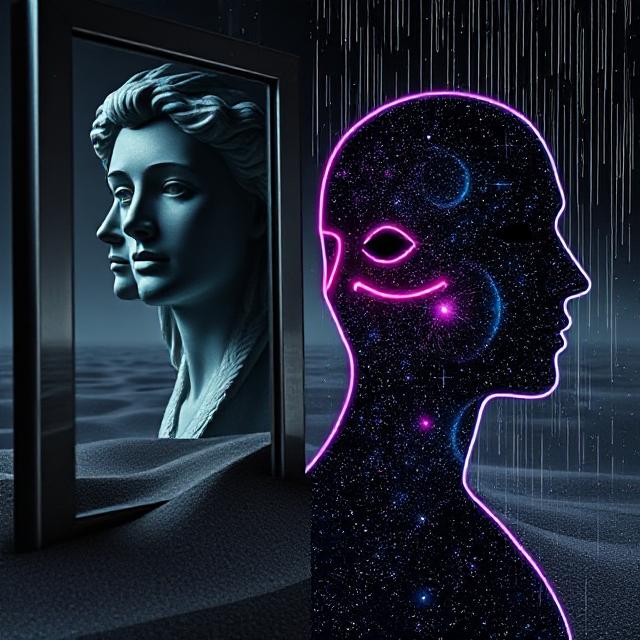
Table of Contents
Self an Illusion or a Constant: What Are We, Really?
Who are you? Are you the same person you were five years ago, or even five minutes ago? These deceptively simple questions lead us into one of philosophy’s most profound and persistent dilemmas: Is the self an illusion or a constant? Is there a fixed, enduring identity at the heart of our experience, or is the self just a convenient fiction constructed by memory, language, and habit?
This article explores the many dimensions of the self through the lenses of Western philosophy, Eastern traditions, neuroscience, and psychology. Along the way, we’ll discover that the answer isn’t just theoretical—it has deep implications for how we live, relate to others, and understand our place in the world.
I. The Classical View: The Self as a Stable Essence
Western philosophy has long leaned toward the idea of the self as a constant. From Plato to Descartes, the self has been imagined as a stable center of thought and identity.
1. Plato and the Soul:
Plato argued that each person has an immaterial soul, distinct from the body, which is the seat of reason and identity. This soul persists even after death.
2. Descartes and “I Think, Therefore I Am”:
René Descartes famously located the self in the thinking mind. The very act of doubting one’s existence, he argued, proves a self exists to do the doubting.
3. Locke and Memory:
John Locke saw personal identity as grounded in continuity of memory. If you remember being the person who experienced something in the past, you are the same self.
These thinkers laid the groundwork for the Western belief in an enduring subject—a continuous “I” that we carry through time.
II. The Eastern View: The Self as Illusion
In contrast, many Eastern traditions deny the existence of a permanent self. Instead, they view the self as an illusion or process.
1. Buddhism and Anatta:
Buddha rejected the notion of a fixed self (atman) and taught the doctrine of anatta or “non-self.” According to this view, what we call the self is merely a bundle of ever-changing physical and mental processes (the five skandhas).
2. Hinduism and Atman:
Ironically, Hinduism takes the opposite stance, positing an eternal, unchanging Atman or soul that is identical with Brahman, the ultimate reality.
3. Taoism:
Taoist thought emphasizes fluidity and the absence of fixed identity. The Tao flows through all beings, and ego is seen as an obstacle to harmony.
The Eastern perspective often encourages letting go of the illusion of a separate self to achieve liberation or enlightenment.
III. Neuroscience: The Modular, Mutable Mind
Modern neuroscience tends to agree more with the illusion theory. It finds no single place in the brain where the “self” resides.
1. The Brain as a Process, Not a Place:
Neuroscientists point out that different brain regions handle different functions—language, emotion, memory, motor control. There is no “central command.”
2. The Default Mode Network:
What we consider “self-referential thinking” is associated with a brain network called the Default Mode Network (DMN). Interestingly, this network is less active during deep focus or meditation—precisely when people report feeling “selfless.”
3. Split-Brain Studies:
In patients whose corpus callosum has been severed, resulting in two independently functioning hemispheres, each half can exhibit different desires, beliefs, and identities. This challenges the idea of a unified self.
4. Memory and Identity:
Neurological conditions like Alzheimer’s and dissociative disorders show how easily the sense of self can fracture. Is the “self” just a memory loop with narrative stitching?
IV. Psychology: The Constructed Self
Many psychologists see the self as a narrative we construct.
1. The Narrative Identity:
Psychologist Dan McAdams argues that people build their identity through life stories. We are our autobiographies, revised constantly.
2. Social Psychology:
Your sense of self changes depending on social roles. Are you the same self at work, with friends, or alone?
3. Developmental Psychology:
Children gradually develop a sense of self. This suggests that identity is constructed, not innate.
4. The Mirror Test:
Even the ability to recognize oneself in a mirror—a hallmark of self-awareness—only emerges around 18 months of age.
V. Arguments for the Constant Self
Despite evidence against a fixed self, arguments in its favor persist:
- Phenomenology: Our direct experience feels unified and consistent.
- Moral Accountability: Ethics depends on continuity of the self.
- Legal Identity: Society functions on the assumption that you are the same person yesterday and today.
- Personal Growth: Concepts like self-improvement or authenticity presume a core self to improve.
Without a constant self, how can we make sense of responsibility, justice, or even love?
VI. Living With or Without a Self
Whether the self is an illusion or a constant isn’t just a metaphysical question—it shapes how we live.
Embracing the Constant:
- Encourages long-term planning, accountability, and integrity.
- Validates your personal narrative and psychological continuity.
- Supports ideas like rights, freedom, and identity.
Embracing the Illusion:
- Can reduce ego-driven suffering and attachment.
- Encourages adaptability and presence.
- Offers spiritual liberation in traditions like Buddhism and Advaita Vedanta.
Middle Path: Process Identity
Some thinkers propose a process model: the self is real, but not fixed. Like a flame, it exists through change. You are a pattern, not a point.
VII. Conclusion: Who Are You, Really?
Is the self an illusion or a constant? The answer may be: both.
We feel like selves. We act like selves. And yet, we change constantly, influenced by biology, context, memory, and emotion. The self may be less a thing and more a verb—a doing, not a being.
In embracing this complexity, we may find new freedom. Not from ourselves, but from the need to pin down who we are. The self is not an anchor—it’s a sail.
